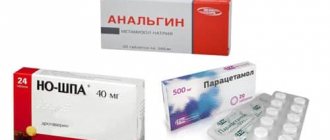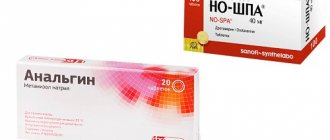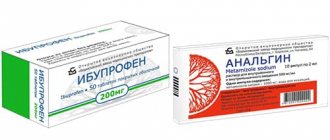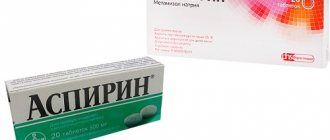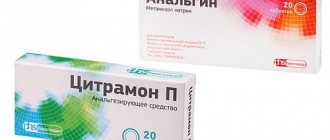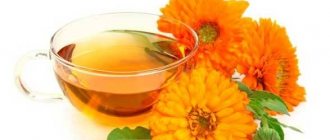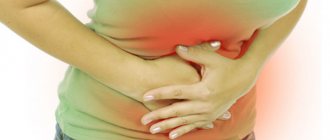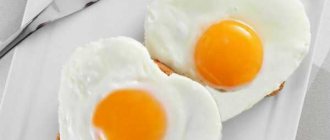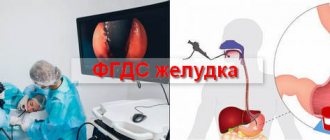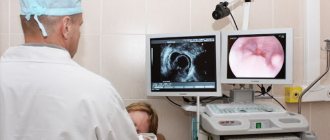Instructions
Analgin and Papaverine are effective means for relieving acute symptoms of the disease. They must be used as prescribed by a doctor in emergency cases.
Analgin and Papaverine are effective means for relieving acute symptoms of the disease.
How to take Analgin with Papaverine correctly?
Medicines are available in different forms, but a more effective combination is a solution for intramuscular injection. Injections can be given after 6 hours (not more often).
Analgin sharply lowers the temperature.
First, Analgin is drawn into the syringe, then Papaverine, but before opening, you need to heat the solution in your palms to body temperature. The needle is held perpendicular to the body and the solution is slowly injected.
Contraindications
Paracetamol, Nurofen, Aspirin, Baralgin and other analgesics with a similar mechanism of action cannot be combined with Analgin.
Lytic mixture is not recommended for children under one year of age, because its use can cause irreversible processes. The drugs can disrupt the body's natural thermoregulation.
Medicines are contraindicated until the cause of the pain localized in the abdominal area, which is additionally accompanied by high fever, is determined. These symptoms may indicate inflammation of the appendix, gall bladder or other pathologies of internal organs. Using these medications will make diagnosis difficult.
Other contraindications include:
- individual intolerance to components;
- acute renal failure;
- traumatic brain injuries;
- disturbance of atrioventricular conduction;
- glaucoma;
- severe liver dysfunction;
- pathologies of hematopoietic systems.
It is not recommended to use these medications during pregnancy. A doctor can recommend them only if the expected benefit of treatment outweighs the potential threat to the mother and fetus.
special instructions
Take Analgin with caution for hypotension.
After acute myocardial infarction and chemotherapy, it is worth choosing a different method of treatment.
If the Analgin ampoule has been opened for 15 minutes, it is no longer suitable for use.
Pregnancy and lactation
In the first 12 weeks and last 6 weeks of gestation, the drug is contraindicated; it can cause abortion. It is not recommended for nursing mothers to take. The effect of Papaverine during pregnancy and lactation has not been established, so the drug should not be taken.
The effect of Papaverine during pregnancy and lactation has not been established, so the drug should not be taken.
Childhood
Children under 14 years of age are not recommended to take medications in one syringe.
We recommend reading: What to choose: Omez or Omez D?
Elderly age
In old age, chronic diseases of the heart and blood vessels often develop. Given this, combinations of drugs are used with caution.
In what cases does the combination of analgin and papaverine help?
Pregnancy, children > Need to know > Analgin and papaverine - what is the name of the drug
A combined remedy of analgin and papaverine, also one of the variants of the lytic mixture, is used in adults and children for emergency care in cases of high fever or other dangerous conditions. The product has a number of side effects, so it should be used strictly according to indications.
Is it possible to mix Papaverine and Analgin in one injection?
Combined remedy of analgin and papaverine
We must start with the fact that such a combination is acceptable. The dosage is calculated according to the weight and age of the patient, especially if we are talking about a child.
The proportions are 1/1, i.e. an equal amount of medications is taken. For greater effectiveness, diphenhydramine or suprastin is added to this mixture.
How does the lytic mixture work and why does it help? If we consider the effect of each drug separately, we can see the following:
- Metamizole (analgin) primarily relieves pain, but as an additional effect it has an anti-inflammatory and antipyretic effect. Used most often to relieve pain.
- Papaverine is an antispasmodic drug that causes relaxation of smooth muscles, including blood vessels. Used as a medicine for spasms.
The antipyretic effect of analgin with a single use is rather weak, but in combination with the vasodilating effect of papaverine it is enhanced. This is one of the reasons why analgin is used, and not stronger antipyretics. There is another side - side effects also increase. The product consists of three components, which is why it got the name triad.
Diphenhydramine has an anti-inflammatory, anti-allergic effect, reduces excessive activity of the immune system. Typically used for severe allergies to relieve symptoms. In combination with analgin and papaverine, it enhances the antipyretic and anti-inflammatory effect.
Suprastin is also an antiallergic agent; it acts a little more gently than diphenhydramine. It is used in the triad instead of diphenhydramine for the same purpose - to enhance the antipyretic effect.
The medicine is used by injection. For formulation, analgin 50% in ampoules, papaverine 2% in ampoules and diphenhydramine 1% in ampoules or suprastin 2% in ampoules are used. The drug ratio is 2/2/1. The exact dosage is calculated based on the patient's body weight. It is possible to use the same drugs in tablets for the same purpose, but they are less effective.
For what purpose is the triad prescribed?
The main purpose of the troika is to reduce the temperature.
Due to the strong effect and large number of side effects, this drug is used only for severe hyperthermia - more than 39˚ in adults and more than 40˚ in infants.
It can also be used for less catastrophic temperatures, if the patient cannot take pills or the temperature has caused a number of side effects (convulsions, weakness, headache with blurred vision).
The drug quickly and effectively reduces fever. The result can be seen within 10–15 minutes – body temperature drops to almost normal.
Basically, the lytic mixture is used to prevent complications, including seizures in children. Analgin and diphenhydramine are considered outdated drugs; they have many more modern analogues, but it is their combination that most significantly reduces temperature, surpassing Nurofen and paracetamol in effectiveness.
Read: Effective vitamin complexes for pregnant women
The triad is used mainly in hospitals or clinics; it is also often used by emergency doctors. It is not advisable to use it at home, although all components, even in injection form, can be purchased at a pharmacy without a prescription. It is acceptable to use triad in children older than six months.
Dosage calculation for children and adults
For adults, the dose is 2 ml of analgin, 2 ml of papaverine, 1 ml of diphenhydramine or suprastin. All components are mixed in one 5 ml syringe and administered strictly intramuscularly. Obese people may require larger amounts of the mixture or twice the dose.
The main purpose of the appointment of the triad
The medicine is injected into the muscle, the injection must occur quickly, since it causes pain, and the faster the drug is administered, the easier the patient will tolerate the moment of injection. The mixture can be administered up to two times per day, the interval between administrations is at least 6 hours.
For children older than six months, there are two algorithms for calculating dosages - by age and by body weight. To calculate by age, a combination of 0.1 ml of analgin and papaverine per year, respectively, 0.05 ml of diphenhydramine is used. Calculating the required dosage is quite easy, and you can do it quickly; all the information the doctor needs is the baby’s age.
Calculation by weight is more complicated, but also more accurate. For every kilogram of the child’s body weight, 0.01 ml of analgin, the same amount of papaverine and 0.0005 ml of diphenhydramine or suprastin must be administered.
Due to the negligible doses in very young children, the antihistamine may not be included in the mixture. The advantages of calculating by weight - it allows you to more accurately calculate the dose of the medicine.
Disadvantages - you need to know exactly the child’s weight, and only parents of small children can have exact figures.
As an example of a calculation, the following diagram can be given. Let’s say the patient is a 6-year-old child weighing 25 kg. If we calculate based on age, then he needs 0.6 mg of analgin, 0.6 mg of papaverine and 0.3 mg of diphenhydramine. If you calculate by weight, the numbers will be as follows - analgin 0.3 mg, papaverine - 0.3 mg, diphenhydramine - 0.1 mg. As you can see, the numbers differ by a factor of two.
Children over 15 years of age take the drug at adult dosages. Triad is not recommended for children under six months old.
Variations in the composition of the triad
There are several types of lytic mixture, and which one to choose is determined by a number of factors. As a rule, the patient’s age, his well-being, the general condition of the body, as well as the presence of certain medications in the hospital are important.
The drug necessarily contains analgin as the main antipyretic component. Replacing it with acetylsalicylic acid or paracetamol does not significantly enhance the effect, but increases the risk of side effects.
Papaverine may not be included in the composition if there is a deficiency in the hospital or if it is contraindicated for the patient. There is no substitute for this drug.
Diphenhydramine is not used in children under one year of age - in such cases the dosage required is too small and will not have the desired effect. If diphenhydramine is contraindicated, it is replaced with suprastin.
Read: How to do an enema at home for pregnant women and children?
The following combinations are possible as part of a combination drug:
- Analgin/diphenhydramine (for adults).
- Analgin/papaverine (for children under one year old).
- Analgin/papaverine/diphenhydramine (the most effective option).
- Analgin/papaverine/suprastin (if diphenhydramine is contraindicated).
The effectiveness of different combinations may vary, and individual factors also play a role. For example, in patients with vegetative-vascular dystonia, the effectiveness of a mixture without papaverine is lower than with it; in patients who do not have such a disease, the effectiveness of both variations is close.
Only a doctor should prescribe a triad and decide which variation will be more effective. Since the drug has a number of side effects, self-medication can be dangerous not only for the health, but also for the life of the patient.
Side effects of triad
Triadic is used once, so its side effects do not have time to fully manifest themselves - for their development, frequent use of the medicine is required. The most common side effect is drowsiness caused by the antihistamine and the sudden drop in temperature, but in extreme heat this is probably a good thing.
Reception of triad
Within 2 hours after the triad injection, the patient is not recommended to engage in physical activity; a sudden transition to a vertical position and sudden changes in temperature should be avoided, as
Possible decrease in blood pressure and orthostatic hypotension.
Performance after taking triad does not increase, and may even decrease, so it should not be considered as a means to quickly get a sick patient back on his feet.
Taking triad can cause bleeding from a stomach ulcer, acute drug-induced hepatitis, aspirin-induced asthma, and blood clotting disorders. As a rule, this occurs in the presence of corresponding diseases.
Individual intolerance to the components of the drug may manifest itself in the form of urticaria, edema or life-threatening manifestations, for example, Lyell's syndrome or Quincke's edema.
This is another reason why it is better to take triad in a hospital.
Frequent use of the lytic mixture can cause addiction to it and insensitivity to other antipyretic drugs. This effect is especially noticeable in childhood, when the patient is most susceptible to such influences.
Overdose and interaction
An overdose occurs if the dose is calculated incorrectly (this is especially common in children, adolescents and adults with insufficient body weight or simply a fragile build), as well as when the lytic mixture is re-administered at intervals of more than 6 hours after the previous administration.
Symptoms of overdose are nausea, decreased blood pressure, facial flushing, difficulty seeing and speaking, lethargy, drowsiness. In severe cases, convulsions, delirium, hallucinations, loss of consciousness are possible, and death is quite rare. But it is not excluded.
Treating an overdose at home is impossible. Parents can give their child enterosorbent (activated carbon, smecta) and call an ambulance. In a hospital, an overdose is treated by administering intravenous solutions (saline, glucose), vital functions of the body are monitored and symptomatic treatment is carried out. If necessary, hemodialysis is prescribed.
Troychatka enhances the effect of anti-inflammatory, analgesic and antipyretic drugs of both non-hormonal and hormonal nature. In this case, the same increase in side effects occurs. The effectiveness of antihypertensive drugs, sleeping pills, sedatives, and antidepressants is also enhanced.
Taking triad during treatment with hepatotoxic drugs (the side effects of which include liver dysfunction) increases their side effects. Combination with cytostatics and antitumor agents is strictly unacceptable. Also cannot be combined with alcohol.
Interaction with other drugs
The drugs can be combined with Diphenhydramine. Taking vasodilators, antipyretics and painkillers has a beneficial effect within 15 minutes after the injection. Troikatka is used to reduce temperature, during a hypertensive crisis, to eliminate the symptoms of acute gynecological and urological diseases.
It is not recommended to use simultaneously with antibiotics.
Analgin is combined with Suprastin, No-shpa, Paracetamol.
Composition of the triad, dosage of drugs
The triad contains three pharmacological drugs, which are extremely cheap, have a relatively small number of side effects, and also have a rapid onset of effect. These include analgin, diphenhydramine and papaverine.
The drug analgin is not used in Western countries due to the large number of adverse reactions and because it is not economically profitable for pharmaceutical companies. It belongs to the class of non-steroidal anti-inflammatory drugs and has many analogues. One of them is aspirin. Both drugs have many adverse reactions associated with inhibition of 2 types of cyclooxygenase. However, to reduce fever, analgin and aspirin remain excellent means.
The drug diphenhydramine belongs to the class of histamine receptor inhibitors and is listed among the first generation drugs. In fact, diphenhydramine is already outdated and is not the most effective for the treatment of allergic diseases. This is due to the suppression of nervous activity at the highest level. After taking diphenhydramine, the vast majority of patients experience drowsiness. For this reason, the “troika” is not an effective means of permanent treatment of allergies, although it can be used at the initial stage of development of a systemic reaction: urticaria, anaphylactic shock, angioedema.
A full-fledged analogue of diphenhydramine that does not have a central effect is loratadine, known under the trade name Claritin. This drug belongs to the class of second generation histamine blockers. In the same category for the treatment of allergies there is fenkarol, peritol, diazolin, simplex. The most effective at the moment are representatives of the third generation of histamine receptor blockers: cytirizine, desloratadine, fexofenadine. Moreover, loratadine remains one of the most commonly used drugs for the treatment of all types of allergies.
Papaverine, as part of the triad, acts as an antispasmodic agent, which is most active in relation to the vascular muscles. An intramuscular injection leads to a decrease in blood pressure, relaxation of the smooth muscles of the intestines, the sphincter of the gallbladder, the major duodenal papilla, and the ureter. Moreover, the functional analogue of papaverine is “No-shpa”.
This drug contains drotaverine, which is more active against the smooth muscles of internal organs rather than blood vessels. No-spa is used in surgical, therapeutic and gynecological practice. Due to the relaxation of smooth muscles, drotaverine and papaverine are able to relieve pain. They are not superior to novocaine in terms of potency, but they eliminate the cause of pain, which is why they are chosen for treatment much more often than other drugs.
Author of the article: Alina Samsonova
In emergency situations, for example, in case of high body temperature, the patient can be provided with medical assistance, which consists of administering an injection of a lytic mixture. The composition of the drug includes Analgin and Papaverine (additional use of other drugs is not excluded). The lytic mixture helps to quickly relieve symptoms and normalize the patient’s condition, but has a number of contraindications.
Papaverine and Analgin together help to quickly relieve symptoms and normalize the patient’s condition, but have a number of contraindications.
Overdose
In case of overdose, symptoms occur:
- nausea, vomiting, stomach pain;
- decrease in urine volume;
- decreased blood pressure, body temperature;
- shortness of breath, tachycardia, tinnitus;
- drowsiness, delirium, impaired consciousness;
- convulsions;
- paralysis of the respiratory muscles.
To relieve symptoms, you need to take sorbents (activated carbon, Enterosgel), anticonvulsants (Diazepam), and do hemodialysis.
Lytic mixture for children: how to prepare it correctly
High temperatures are very dangerous for babies. If it is not lowered in time, the child sometimes experiences febrile convulsions. When the baby's condition is critical, it is recommended to call an ambulance. When parents do not have such an opportunity, they give him a lytic mixture.
- 1 What is a lytic mixture?
- 2 Indications for use
- 3 Composition
- 4 Injections
- 5 Tablets
- 6 Table of application of lytic mixture
- 7 Interaction with other means
- 8 Side effects and contraindications
- 9 Doctor Komarovsky about the lytic mixture
- 10 Frequently asked questions
What is a lytic mixture?
Several medications are mixed into one mixture or solution to instantly lower a high temperature. This composition has a name - lytic mixture for children.
It is used when you need to “bring down” a fever. An antipyretic should not be given to a baby if his temperature is 38˚C. This indicator indicates an adequate response of the body to a viral attack.
Indications for use
A lytic mixture for fever for children is used to quickly alleviate the serious condition of the patient. It is used when the fever is more than 38˚C, and all other antipyretics have not given the expected result.
A lytic mixture is given to children if fever provokes seizures. Parents should carefully examine the condition of their sick child. If he has a fever, and his legs and arms are cold and his skin is too pale, he must be given medicine immediately.
Compound
A potent lytic drug in injections is usually used by emergency doctors when they need to quickly “bring down” a fever that is too high. The classic composition of this complex drug consists of three main components. Each of them alleviates the patient's condition.
Composition of the lytic mixture:
His share is 50% of the rest. It is an antipyretic analgesic.
Enhances the activity of Analgin. His share is 1% of the rest. This is an antihistamine that relieves allergic reactions. Additionally, it has a sedative effect. Can be replaced with Suprastin or Tavegil.
Antispasmodic, dilates blood vessels. Belongs to the group of opium alkaloids. Increases heat transfer, reduces the risk of seizures. Its part is only 0.1% of the total composition. Can be replaced with No-shpa.
Important! When combined together in one mixture, these drugs do not form any new composition. They just enhance each other's effect. All the ingredients of a lytic remedy do not cure any disease. They only jointly relieve the acute symptoms of the inflammatory process, that is, they quickly “bring down” the fever.
Injections
Injections that include two or three medications at once are given to children over three years of age no more than once every 6 hours, and for children under three years of age - once every 24 hours. They are used if antipyretic syrups and suppositories do not help the baby. Intramuscular injection. Improvement occurs after 10 minutes.
Analgin with Diphenhydramine
Children under 1.5 years old are often given injections of two medications when they have a fever - Analgin and Diphenhydramine. Together, these drugs have a rapid fever-reducing effect.
Composition of infant formula (up to 1.5 years):
- Analgin: 10 mg multiplied by weight in kg.
- Diphenhydramine: 0.1 ml.
It’s easy to give an injection: you need to take a 2 ml or 5 ml syringe and draw the required amount of medicine from the ampoules. The injection is given in the upper outer quadrant of the buttock. The needle enters the muscle perpendicularly. The medicine is administered smoothly and very slowly.
Troychatka – Analgin, Diphenhydramine, Papaverine
The triad is prepared from three medications. For babies up to 12 months and children after one year, the composition of this mixture is slightly different. With age, the amount of active substances increases.
Troychatka for children up to 12 months:
- Analgin (50%): 10 mg multiplied by the baby's weight.
- Diphenhydramine (2%): 0.1 ml.
- Papaverine (2%): 0.1 ml.
How many ml of each drug is taken for formula for children after 1 year:
- Analgin (50% solution of Metamizole sodium): 0.1 ml multiplied by age.
- Diphenhydramine (2%): 0.1 ml multiplied by age.
- Papaverine (2%): 0.1 ml multiplied by age.
Important! The medicinal mixture should not be prepared by eye. You need to keep the proportions exactly. For children under one year of age, the dose is calculated based on body weight, and after one year - based on the number of full years lived.
Analgin, Paracetamol, Suprastin (Tavegil, Fenistil)
Troychatka is also prepared with Suprastin or Tavegil. These drugs have an antiallergic effect. They are used to reduce the level of toxicity during the inflammatory process.
Recipe for preparing the mixture:
- Analgin: 0.1 ml multiply the number of full years.
- Paracetamol: 0.1 ml multiplied by the number of completed years.
- Suprastin: 0.1 ml multiply the number of full years.
Before injecting the ampoule, you need to hold it in your hand for some time to warm it up. The administered medicine must be at body temperature. The syringe is used only for disposable use. Does not apply again. All components of the mixture are mixed in one syringe.
Analgin, Diphenhydramine, No-spa
Instead of Papaverine, it is allowed to take No-shpa. This drug also exhibits antispasmodic and vasodilator activity.
Lytic mixture - dosage calculation for children:
- Analgin: 0.1 ml times age.
- Diphenhydramine: 0.1 ml times age.
- No-spa: 0.1 ml times age.
Important! The lytic mixture for fever is a very powerful remedy for lightning-fast fever relief. It may cause an allergic reaction. They first check how the body will react to the product: a couple of drops of the mixture are applied to the skin of the face. If no redness or irritation appears, the injection can be given.
It is not recommended for a non-specialist to give injections on their own at home. It is better to call an ambulance at home. Before the doctor arrives, the child can be given plenty of fluids.
Pills
The lytic remedy for fever does not have to be given as an injection. If the child is conscious and not vomiting, he is allowed to be given pills. They should first be crushed into powder. Take this product with water.
True, improvement in the condition will occur only after 30 minutes. The patient's fever will subside, he will sweat a lot and want to sleep. Be sure to change wet clothes and change your baby into dry pajamas.
Analgin, Paracetamol, Suprastin
A child over three years old can be given a mixture of tablets. The product must first be prepared, that is, the tablets must be crushed into powder.
Lytic mixture for children in tablets (from the whole part):
- Analgin: ¼.
- Paracetamol: ¼.
- Suprastin: ¼.
The powder is poured into a spoon and mixed with a small amount of boiled water. The medicinal mixture is washed down with warm tea or compote.
Analgin, Paracetamol, No-spa
If you don’t have Papaverine in your home medicine cabinet, you can replace it with No-shpa. The dosage of drugs of the same type is not changed.
Lytic mixture for children - dosage of the drug in tablets (from the whole part):
- Analgin: ¼.
- Paracetamol: ¼.
- No-shpa: ¼.
Analgin should be used carefully to relieve fever. This remedy may irritate the stomach lining and lead to severe abdominal pain and diarrhea.
Baralgin, Papaverine, Suprastin
The dosage of the drug is prescribed by the doctor based on the severity of the disease and the age of the baby. You can give children only minimal doses of the drug on your own. For example: an adult is given one whole tablet of each remedy for fever at one time.
Lytic mixture for children - composition (from the whole part):
- Baralgin: ¼.
- Papaverine: ¼.
- Suprastin: ¼.
Before using crushed tablets, it is recommended to consult a doctor. Exceeding the dosage is not allowed. After 6 hours, if the fever does not subside, you can take the drug again in the same proportions.
Lytic mixture application table
Table of the maximum dose of the lytic mixture:
| Weight, kg | 3 | 6 | 10 | 12 | 14 | 16 | 18 | 20 |
| Single dose, ml | 0,3 – 0,45 | 0,6 – 0,9 | 1,0 – 1,5 | 1,2 – 1,8 | 1,4 – 2,1 | 1,6 – 2,4 | 1,8 – 2,7 | 2,0 – 3,0 |
| Daily dose, ml | 1,2 – 1,8 | 2,4 – 3,6 | 4,0 – 6,0 | 4,8 – 7,2 | 5,6 – 8,4 | 6,4 – 9,6 | 7,2 – 10,8 | 8,0 – 12,0 |
Interaction with other tools
Sometimes Novocain is added to the lytic mixture along with Analgin and Diphenhydramine. This drug has an analgesic effect and reduces the intensity of the inflammatory process. Novocaine often causes an allergic reaction. It should not be prescribed as an antipyretic to children.
The lytic mixture is not prescribed if Diphenhydramine or Analgin has already been used as independent drugs. Taking a double dose of the same medicine may cause unwanted complications.
Side effects and contraindications
Using medications without the permission of your pediatrician can lead to side complications. And nalgin sometimes leads to the development of acute gastritis, which is accompanied by stomach pain and diarrhea. Sometimes medications cause a child to develop a skin rash, vomiting, and convulsions.
If you are allergic to the active components of one of the drugs, you should stop using the entire composition.
The lytic mixture cannot be used in the following cases:
- for acute abdominal pain, if there is a possibility of appendicitis;
- if you are allergic to the components of the mixture;
- children under 6 months;
- 3 hours after taking medications containing Analgin.
In case of an overdose, the child may experience vomiting, a sharp drop in temperature, and difficulty breathing. In this case, the use of medications should be stopped. The child's stomach is washed and given a large amount of liquid to drink. Be sure to give a sorbent (activated carbon or smecta).
If convulsions occur, you should call an ambulance.
Dr. Komarovsky about the lytic mixture
Dr. Komarovsky believes that it is better to reduce fever with injections. At high temperatures, the body suffers from a lack of fluid. Blood supply is concentrated only in vital organs. Absorption of antipyretics through the intestines slows down.
- During a fever, your baby needs to be given water often.
- The air in the room should be cool.
- Do not tightly wrap a child with a high temperature.
- Clothes should be loose.
- If the baby is sweating, the clothes need to be changed to dry ones.
FAQ
How long does it take for the lytic mixture to work?
The injection usually takes effect within 10 minutes. The fever disappears, the temperature drops to 37˚C. The child’s arms and legs become warmer. The effect of the antipyretic drug lasts for 4 – 6 hours. If after some time the temperature rises again, the baby must be urgently hospitalized in the hospital.
How to store the mixture?
It is recommended to store the injections or tablets from which the mixture is prepared out of the reach of children. Preferably in a dry place at room temperature. The entire dose of medication is not prepared in advance. Each ampoule is opened only before the injection itself.
Unused product can be stored in a cool place for 6 hours. If the fever goes away, open ampoules are thrown away.
The same goes for tablets: unused shares can only be stored for 24 hours. If there is no need to re-give the product, they are thrown away.
Is the drug dangerous for children?
The drug is not dangerous if it is not used frequently, but only in critical cases and as prescribed by a doctor. The drug cannot be used every time the temperature rises. A lytic remedy is given to a child only when all other antipyretics have not produced any results and there is an urgent need to “bring down” the fever.
Source: https://kinders.online/bd/detlekarstva/liticheskaya-smes.html
Injections with Diphenhydramine
High temperature appears in various diseases and painful conditions. Since not only an adult, but also a child can have a fever, parents need to know how and with what to bring it down.
Popular Improving blood clotting with Heparin injections
Doctors advise fighting signs of temperature after 39 degrees. Today there are many pharmaceutical agents that help reduce fever. But the most effective substance for reducing fever is considered to be an injection of three drugs - Analgin + Papaverine + Diphenhydramine. Since the injection solution contains three drugs, they have different effects and reduce the rising temperature well.
This unique medicine will help with inflammation, and also with the diagnosis of acute respiratory viral infections. The drug is much more effective than different tablets, since its effect is combined compared to other medications. Often used by emergency physicians as the first remedy to relieve a patient's fever. This is one of the most common combinations that everyone should know.
Reviews about the drug Papaverine
Reviews about the pharmaceutical drug can be found on various forums, since the wide range of effects of the biologically active element makes it possible for patients to evaluate the effect of the drug. For example, a doctor often prescribes medicine for patients with hemorrhoids.
On the other hand, one can see positive feedback about Papaverine suppositories during pregnancy, since the antispasmodic and soothing qualities of the functioning element make it possible to productively eliminate the condition, which is characterized by prolonged tension in the muscular layer of the uterus before the onset of labor. The duration of the effects acquired from injections depends on certain conditions:
- General condition of the body;
- Causes of hyperthermia;
- Features of the course of the disease.
Most often used to reduce temperature. The lytic mixture holds the result against heat for quite a long time (6-8 hours). Let's analyze the responses of patients:
When I was in confinement, there was a danger of pregnancy failure. The doctor prescribed the medicine in the form of injections, with a dosage twice a day. Papaverine was injected for 5 days. At the same time, after one injection, the pain in the lower abdomen gradually decreased. To be honest, even after giving birth I often use this drug. This is a really good pain reliever, and it is absolutely harmless and there are no side effects.
I take medications quite rarely, but during pregnancy I had to use Papaverine rectally. The doctor diagnosed me with a toned uterus, so he prescribed me a safe remedy. The advantages of the substance include the rapid action of the result, approximately twenty minutes after the injection. In addition, after the injection, no secondary results appeared.
This is generally one of the drugs that can be injected while pregnant, so it is absolutely harmless to the baby’s well-being. As for the shortcomings, I didn't notice any. The only thing that a pregnant woman may notice is a lethargic state after the effect of the drug. However, I do not consider this a disadvantage, since a woman is also not always active during pregnancy. Therefore, I am pleased with the result of the medicine, since my main condition has improved, and the medicine does not harm the baby.
A good, inexpensive pharmaceutical drug that is suitable not only when the uterus is in good shape, but is used for children's electrophoresis. At one time we underwent 2 courses of sessions with Papaverine. The solution was kept with electrodes in the neck area. My daughter had torticollis on the left side, as well as hypertonicity of the back muscles. After one course, improvements were already visible, the child began to hold his head straighter. Of course, only 10 sessions are not enough for complete treatment, and much still depends on the child’s health condition and other diagnoses. But electrophoresis with Papaverine helped us.
Dosage, proportions for children and adults
In the injection of Papaverine, Analgin and Diphenhydramine, the dosage of each component is calculated separately. It differs for children and adults and is selected according to the patient’s weight. For a child, the amount of drugs depends on age:
- up to one year - Analgin: 10 mg per kg of body weight, Diphenhydramine - 0.1 ml, Papaverine - 0.1 ml;
- after a year - all three components are taken at the rate of 0.1 ml, multiplied by the child’s age (only full years are counted).
It is not always possible to give an injection, so in some cases it can be replaced with tablets. But this scheme can only be used after reaching 3 years of age. For this you will need:
- 1/3 Diphenhydramine;
- ¼ Analgin;
- ¼ Papaverine.
The tablets need to be crushed into powder and then dissolved in a spoon of water. The resulting mixture is given to the child to drink. The therapeutic effect appears after 20-30 minutes, but lasts the same time as after a troika injection.
For children aged 15 years and older, as well as for adult patients weighing more than 60 kg, 2 ml of Analgin and Papaverine will be required, and Diphenhydramine should be taken 1 ml. For higher body weights, 1/10 of this dosage is added for every 10 kg. All drugs are drawn into one syringe and administered intramuscularly.
If the child is not yet 8 years old, the dose of Analgin for him is best calculated by weight. To determine the daily amount of such a medicine, the child’s weight in kilograms is multiplied by 5 or 10. This calculation accurately determines the amount of metamizole sodium in milligrams acceptable for a particular baby.
The resulting amount is divided into 2-3 single doses. However, they should not exceed 100 mg for children under three years of age and 200 mg for children aged three to eight years. For a child over 8 years old, a single dose of Analgin is 250-300 mg of its active substance, and for 14 years and older it increases to 500 mg.
The dosage of Diphenhydramine injection solution is determined by the age of the child:
- If the baby is from 1 to 3 years old, then 0.5 ml of the drug is administered, but the dose, if necessary, can be increased to 1 ml of the drug.
- For children 4-6 years old, the dose of the solution for one injection is from 1 to 1.5 ml.
- At the age of 7 to 14 years, 1.5-3 ml of the drug is taken per injection.
Action
These medications are available in the form of tablets and suppositories, but the most effective solution is considered to be an injection solution in ampoules.
Analgina
Analgin is a drug that has an analgesic effect. This medicine belongs to the category of non-steroidal drugs and has the following effects on the body:
- antipyretic;
- anesthetic;
- anti-inflammatory;
- antispasmodic.
Maximum effectiveness occurs 2-3 hours after administration.
Analgin is a drug that has an analgesic effect. This medicine belongs to the category of non-steroidal drugs.
Papaverina
Papaverine belongs to the category of opium alkaloid drugs. It has the following pharmacological properties:
- antispasmodic;
- anticonvulsant;
- sedative.
In addition, it normalizes the functioning of the heart muscle.
